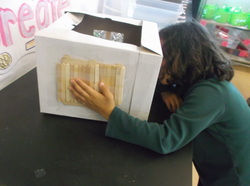
Way to go Kindergarten! You're on your way to first grade engineering! YAY!
Fabric is a technology that every one of us encounters on a daily basis. Whether it's part of the clothes we wear, or the furniture we sit on, fabric has unique properties depending on the purpose for which it is used. Kindergartners will be exploring many types of fabric, learning key vocabulary that can describe the properties of not just fabric, but many other materials engineers use to develop the technologies we all use.
 With their last design challenge of Kindergarten among them, Kindergartners are using what they know about various materials to develop technologies to block out the light from a sleeping baby's room. The baby keeps waking up because the room is too bright, so students are designing and creating technologies that can keep the room dark enough to keep the baby asleep! Way to go Kindergarten! You're on your way to first grade engineering! YAY! 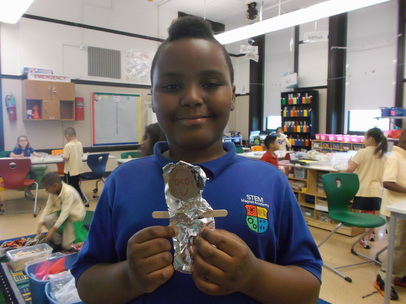 Look at what this student did to keep his person dry! Look at what this student did to keep his person dry! Engineers are true problem solvers! They design technologies that meet either needs or wants, and they are often constrained by the materials they have available. Kindergartners are completing some of their last design challenges of the year. Their first goal--to design a solution to keep someone dry! Using a wide variety of materials (including all the fabric they studied), they must keep their stick figure person dry against the rain (which is really a squirt bottle). Can they do it? We'll have to test it to find out! 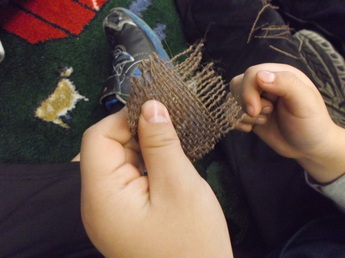 Now that Kindergartners are experts on the properties of different fabric, they are seeing how engineers must also know about the process of how things are made. Technologies are not just objects, but they can be processes, too! A process is the steps needed to design something or accomplish a goal. Kindergartners first took burlap fabric apart, and then they began the weaving process to create their own fabric. Not all fabric is woven--some of it is knitted. Check out their weaving process below! Now that Kindergartners have mastered many new properties to describe fabric, they're moving on to learn properties that describe other types of materials, too. Our next focus will be on how each material allows light to pass through it. Materials that let light completely through them are considered transparent. This allows us to see on the other side of the material. Materials that partially allow light to pass through them are translucent. The objects on the other side of them appear cloudy. And materials that do not allow any light to pass through them are considered opaque. We can't see what's on the other side at all! Kindergartners did the "Can you see the letters?" test to begin classifying materials that are transparent, translucent and opaque!
Kindergartners are stepping up their vocabulary game by expanding the scientific words they know! Using dropper bottles and various samples of fabric (thanks again to everyone who donated some!), they are looking for evidence that the water absorbed into their fabric by looking below it. Words we're hoping to master: ABSORBENT and WATERPROOF! Way to go Kindergarten!
Welcome back from Spring Break! Kindergartners are focusing on the importance of sorting materials by their properties. Each team of students had the opportunity to sort fabrics according to how they thought they should be sorted. Some groups sorted by color, others by texture, and others by how light interacts with them! How neat!
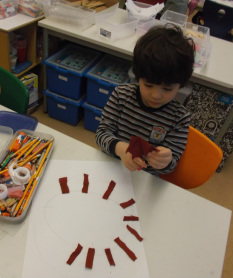 As Kindergartners become "properties experts" they're putting all their properties knowledge into action building a fabric collage. Fabric can be many different properties and Kindergartners continue to explore these differences! 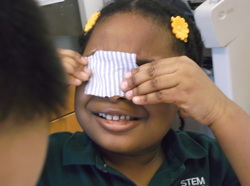 As Kindergartners dig deeper into understanding the many properties fabric can have, this week's focus was on understanding the new vocabulary words of bendy and rigid. All of our fabric has the property of being bendy! Rigid materials are stiff and unable to bend. Kindergartners are also curious about whether they can see-through fabric! We'll be exploring how fabric interacts with light soon! 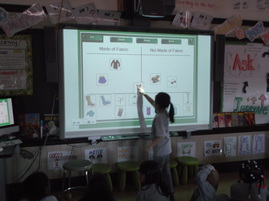 Kindergartners have officially begun a new unit on fabric! Fabric is a technology that can help us in many ways. As we start the unit, Kindergartners will be introduced to the many types of fabric there are, as well as the different properties they all have. Each fabric has unique properties that are suited to the purpose for which it is intended. Students will be expanding their vocabulary to include words that are associated how the fabric interacts with light, its texture, its elasticity, its absorbency, and much more! Thanks to all the families that donated fabric to our class! We're about the start our unit on fabric!
|
What can be some purposes of fabric?-To keep you warm. Archives
May 2014
Useful Links
|